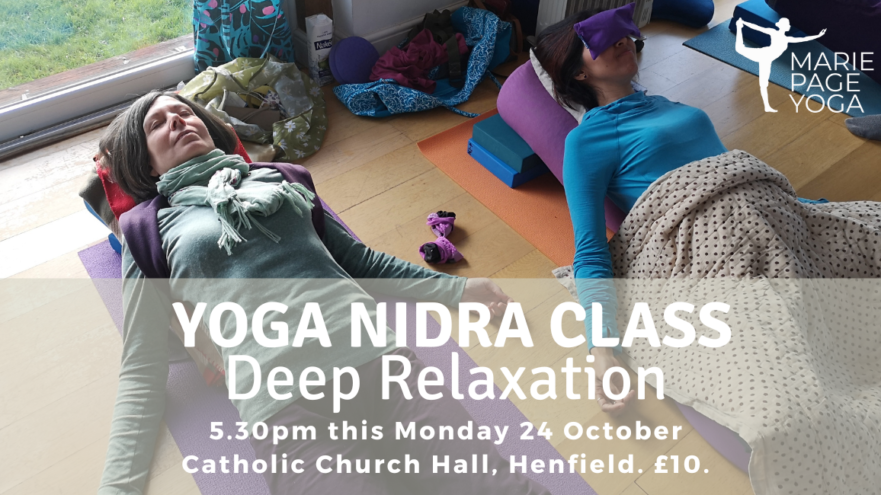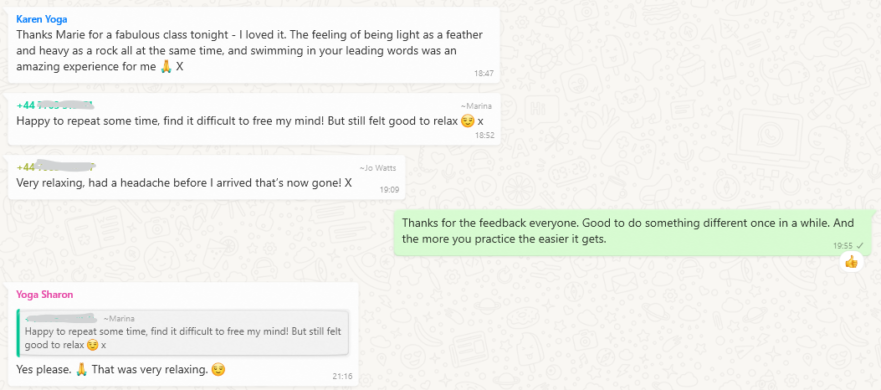
23rd October 2022
Modern life is frantic. And even though we know we should learn to calm down and relax we either struggle to find the time or alternately find that once we are in a place of being rather than doing the mind is frantically busy reminding us of everything that has to be done and interrupting any thoughts of calm with a clamouring background chatter.
I’ve been experimenting with more gentle, restorative yoga classes on Monday evenings in recent weeks. It’s been an interesting experience to do this with people that have no previous experience of a more meditative approach to yoga. People often come to yoga because they want to gain flexibility, get a bit fitter or perhaps improve their strength or balance. But this physical manifestation of yoga – Asana as it is known in Sanskrit – is just one of the eight limbs of yoga. The other limbs of yoga are more challenging to access, especially for those of us living normal, busy lives.
In common with most yoga classes in the West the majority of my classes are focussed on Asana – making shapes with our bodies – creating yoga “postures”. But I also regularly introduce another limb, that of Pranayama. This is the breathwork. We try to be aware of the breath while we are in our postures and I will encourage students to inhale with one movement, exhale with another and focus on using the breath to help them physically and mentally relax. I will often use breathwork exercises (such as the Pranayama Square, Alternate Nostril Breathing, Circular Breathing or Savitri Breath) to help us bring focus to our fuller yoga practice.
You’ll also find me sneaking in other aspects of the eight limbs of yoga into my classes. One, for instance, is Niyama – the process of self observation. Whilst I don’t remember ever using the word Niyama in a class, you will have heard me talking about noticing things in the body, about being mindful or focusing on what it means to fully embody a pose.
I also often talk about the benefits of breathwork to help us engage the para sympathetic nervous system (rest and digest rather than fight and flight) – that’s all regular science rather than any yogic weirdness. Mindfulness approaches have been popular in recent years for good reason. Our minds and bodies need time and space to rest and heal.
Some teachers integrate spiritual teaching or yoga (including Hindu) philosophy to their classes. This isn’t something I tend to do as I know many people find it off putting or somewhat alien to their western experiences. But I do try to introduce some of the practices that enable us to more fully embrace the opportunities that yoga can bring. Some might accuse me of teaching “Diet” or “Low Fat Yoga” but my motivation is simply to make the wider practice more accessible to people that would benefit from it. Personally I love a collective OHM and to listen to an able practitioner chant, but the latter at least, is not something I bring to my classes. There are plenty of teachers that do incorporate those things – I would encourage you to go and find a teacher that offers what you are looking for.
What I am trying to bring, however, is a deeper ability to relax. As life has resumed its manic post pandemic pace I have students juggling work and family commitments as well as health concerns and all manner of crises. There is very much a place for physical yoga to help the body respond to these stresses but also a place for the other aspects of yoga to work their magic. And I find that once my body has been stretched and physically calmed, my mind is then ready to settle.
Breathwork helps with this calming process but there are other yogic techniques available to us. Restorative yoga, where we hold postures (always supported by the floor and various props) for longer periods allow us to access deeper levels of concentration (Dharana), perhaps a certain disassociation of consciousness from the outside environment (Pratyahara) and a more meditative state (Dhyana). [These words are from the eight limbs of yoga.] Rather than being sceptical of these I would encourage you to go with the flow, try to embrace and lean into the relaxation and mental release they offer.
Being able to lie or sit without the mental chatter constantly interrupting is difficult. And it does take a little while to learn. This is why I include breathwork, counting patterns, even the little Paced Breathing (inhale and exhale) app I use on my phone to help us focus. I’m learning what a diverse group of people need to help them go a little deeper. Whether that is via a physical posture or a breathwork approach. The next approach that I want to explore is Yoga Nidra.
Yoga Nidra
Yoga Nidra is a form of meditation that I find is more accessible to people that tend to struggle with meditative approaches. It is described as ‘yogic sleep’ – a state of consciousness between waking and sleeping which I know sounds very woo woo. And as someone who would in the past have been very sceptical about such things I can tell you that I have loved every Nidra experience I have been involved in. I’m someone that juggles four different job roles, is always on the go, wakes early, constantly has a list of things to do. I am not your calm hippy type that can easily pass the day without activity. But Nidra has helped me break through my previous inability to simply relax.
Yoga Nidra has so many benefits. It is hugely relaxing and yet also refreshing. An hour of Nidra is said to equal several hours of regular sleep. Personally I’d describe it as a little hypnotic, and I guess it does draw from some hypnotherapeutic approaches. It’s explained in detail here.
If you’d like to experience Yoga Nidra let me know. I occasionally use it in classes and can certainly incorporate it into any class where requested.
Feedback on Yoga Nidra class
